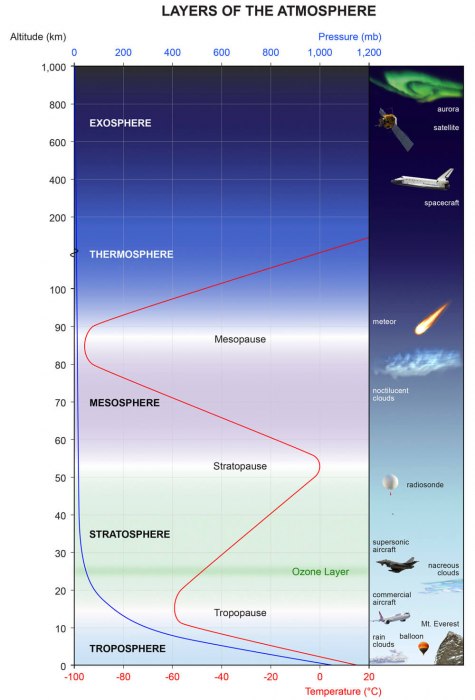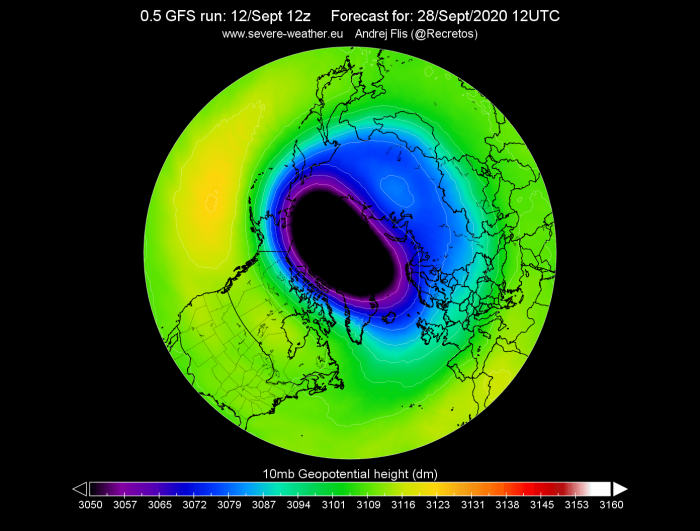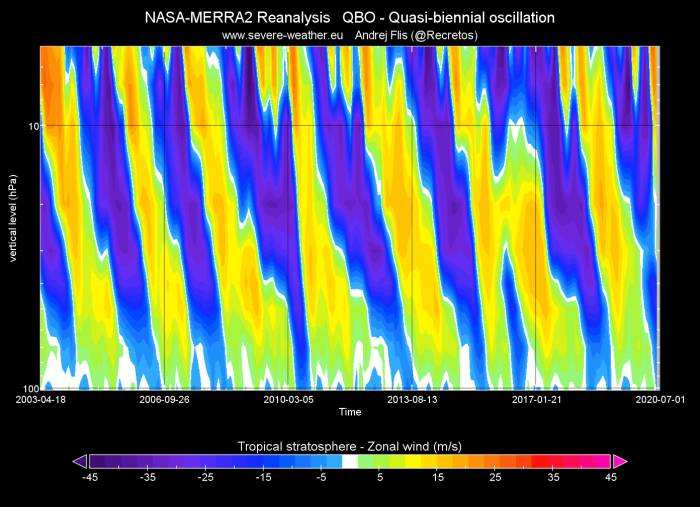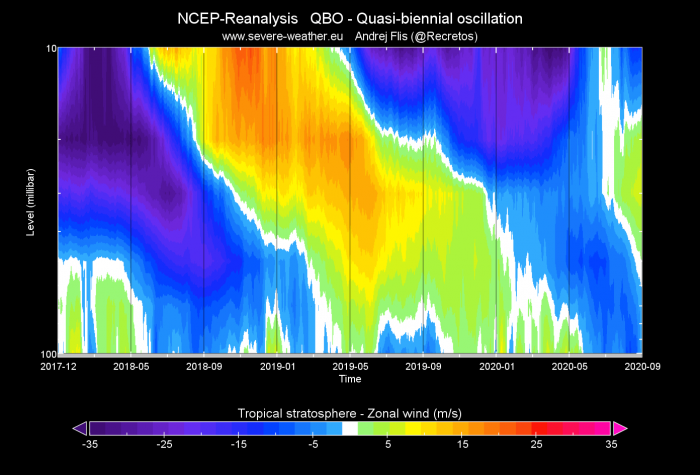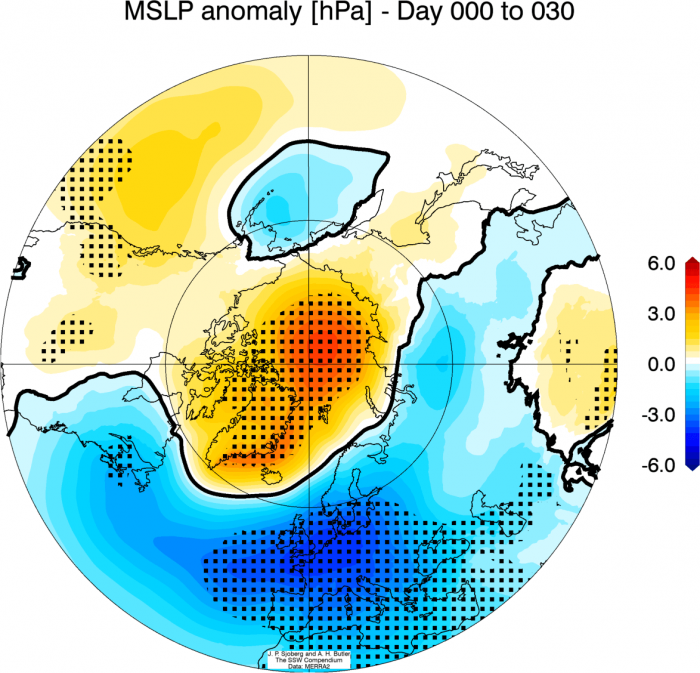The road to the next Winter season is always long and it begins well before the temperatures start to drop. One of the major drivers on that road is the stratospheric polar vortex. A new polar vortex has now emerged over the North Pole and will continue to strengthen for the next 4 months.
In our latest long-range article, we discussed the latest Fall forecast 2020. There we mentioned the influence of the ENSO cycles in the tropical Pacific, and what they are.
Now we turn away from the ocean and into the Stratosphere. There, a new polar vortex has emerged and began to grow, to be ready for the upcoming cold season.
WHAT IS THE POLAR VORTEX?
The atmosphere above us has many different layers. All of the clouds and the weather that we feel are found in the lowest part of the atmosphere called the troposphere. It reaches up to 8 km altitude over the poles and up to 14-16 km altitude over the equator.
Above it, there is a much deeper layer called the stratosphere. This layer is around 30 km thick and is very dry. The pressure on top of the stratosphere is 1000-times lower than on the ground. Unlike in the troposphere, the temperature in the stratosphere increases with height. The image below shows the layers of the atmosphere, with the stratosphere in green hues. The red line nicely shows the temperature progression with height above the Earth.
Every year as we head into autumn, the north pole starts to cool. The solar input to the north pole decreases as the angle of incoming solar rays reduces. Eventually, the solar angle is so low, that no direct Sun rays reach the north pole. That is known as the “polar night” when the Sun stays permanently below the horizon. The image below shows the temperature graph for the past two years in the middle stratosphere. We can see the seasonal temperature cycle. It corresponds to the length-of-day and the angle of sunlight, or lack thereof.
The reduction in temperature also coincides with a gradual pressure drop over the north pole. In the stratosphere, the process is the same. Due to the temperature changes over the pole and the increasing temperature difference with the warmer air further south and the effects of earth spinning, a low-pressure area starts to develop across the stratosphere. It is like one very large cyclone, covering the whole north pole, down to the mid-latitudes.
The polar vortex is not found only in the stratosphere, but it reaches all the way down to the ground. We can see in the example image below for late October, how the polar vortex looks at different altitudes. A one large cyclonic circulation area. The lower we go, the more dynamic or “disrupt” it is. That is because of the effects of terrain, like mountains on the circulation and the weather fronts.
We produced a high-resolution animation, which shows the birth of the stratospheric polar vortex this year. Notice, in the beginning, the north pole is dominated by high pressure. Eventually, a small cyclonic area appears, which grows larger as the Arctic atmosphere cools down.
Currently, the temperature is already dropping in the stratosphere. The image below shows the temperature difference forecast in the next two weeks, in the middle stratosphere. We can see the large-scale cooling over the majority of the North Pole.
The pressure is also starting to drop rapidly. Looking at the current geopotential height of 10mb (~30km altitude), we can see the smaller low-pressure area starting to develop over the Arctic Circle. That is the foundation for the polar vortex of the upcoming winter 2020/2021. The second image shows the forecast for late September, where we can see the polar vortex much more developed, and rapidly increasing in size and influence.
The stratospheric polar vortex is an integral part of every winter pattern. It is directly connected with the lower atmosphere and our weather. It packs a lot of energy, a lot in the form of wind and/or rotational energy. A strong vortex can dominate the circulation across the northern hemisphere, and create a very mild winter, as it spins and locks the cold air into the Arctic Circle.
A weak vortex event can also affect the pattern in the opposite way. A disruption wave is required to severely weaken the stratospheric polar vortex, which can then move top-down from the stratosphere, creating a high pressure at the surface over the north pole and a cold winter pattern for the United States and Europe.
The current forecast shows the stratospheric jet stream developing. This is also called the Polar Night Jet (PNJ short). The first image shows the stratospheric jet stream in the upper stratosphere at 1mb level (~45km) and the second graphic shows the stratospheric jet stream at the 10mb level (~30km).
The strength of the stratospheric jet stream at 10mb level (~30km) is usually used to determine the strength of the polar vortex and its potential influence on weather in the winter when strongest. Current forecasts, when compared to the long-term average, show that the late September strength of the polar vortex to be below average. That is seen in the image below which shows the forecast of the stratospheric jet stream at 10mb (~30km), compared to the long term average (yellow line). This might not mean much for now, but it shows that the polar vortex is off to a more sleepy start.
Looking at the wind energy, we produced a unique image below, which shows the forecast of west-to-east (zonal) winds over the entire earth, from the south pole (-90°) to the north pole (90°). We have highlighted some of the important features on the graphic:
- Black box: This shows the very strong stratospheric jet stream over the southern hemisphere. This is currently associated with a strong stratospheric polar vortex over the South Pole. We can see its connection down to the tropospheric jet stream.
- Violet box: Here we have our own stratospheric jet stream developing over the northern hemisphere. It is not nearly as strong as the one over the south pole, but it is only starting to develop.
- Blue box: This is the “regular” jet stream as we know it, in the troposphere, at around 8-10km altitude. We can see that it is not very strong yet, as it is only starting to develop. We can also see that it is not yet connected fully with the main stratospheric jet stream.
- Red box: Last but not least, we get to the red box, which is more important then it might look like at first. This shows the Quasi-Biennial Oscillation (QBO) above the Equator, a regular shift in wind direction from west to east.
THE HEARTBEAT OF THE ATMOSPHERE…
The Quasi-Biennial Oscillation (QBO short), is a regular variation of the winds that blow high above the equator. Strong winds in the stratosphere travel in a belt around the planet, and every 14 months or so, these winds completely change direction. This means that every year or so winds high above the equator change from west to east.
A wind analysis for the 30mb level (~24km), shows this wind stream above the equator. It is currently in positive values, which reveals that westerly winds are prevalent. This means that the QBO is in the west mode.
We can see these west and east phases in a quite simple image. Below we see the zonal (W-E) winds in the stratosphere above the equator over time. It is obvious right away that this is a very regular shift from west winds (positive values) to the easterly winds (negative values). This shift from west to east winds is so regular, that it gave QBO the nickname “heartbeat of the atmosphere“. Each phase slowly descends down over time, from the middle stratosphere around 10hpa (~30km) down to the top of the troposphere around 100hpa (~17-18km).
Looking more closely at the past year and a half, we can see how each phase descends over time. But the official definition of the QBO phase is around the middle of the image, between 30mb and 50mb level. We can see on the latest data for September at the end of the graphic, that positive values are starting to emerge, corresponding to a west phase. This is rather unusual, as the west phase is not descending like it normally does.
A radiosonde analysis from Singapore also shows the wind direction above the tropics. It reveals the west winds around 30-50mb level, confirming the west QBO phase will be dominant this winter.
The QBO is also an important part of weather development in winter, as it can affect the Atlantic jet stream. The speed of the winds in the Atlantic jet stream weakens and strengthens with the direction change of the QBO. The jet stream is an important atmospheric feature that brings us our weather, and the risk of winter conditions across the Northern Hemisphere can differ depending on the phase of the QBO.
- When the QBO is easterly, the chance of a weak jet stream, sudden stratospheric warming events, and colder winters in Northern and Central Europe and the United States is increased.
- When the QBO is westerly, the chance of a strong jet, a mild winter, winter storms, and heavy rainfall increases.
IT ALL COMES TOGETHER IN WINTER…
The stratospheric polar vortex, the QBO, and the ENSO cycles are heavily connected. A different combination of these factors can give a very different outcome each winter. These are not the main drivers of the winter patterns (as the weather is not so simple), but are aiming for the top positions. To further increase the odds for proper winter weather, we usually aim for the Sudden Stratospheric Warming event. You can learn more about it in the linked article.
Simplified, a Sudden Stratospheric Warming event (SSW) is exactly what the name suggests. It is a sudden temperature rise in the polar stratosphere during winter. Warming of the stratosphere means that the polar vortex is weakened, and can also collapse under the pressure from the warming event. This can create a chain of events, which can disrupt the jet stream, and create high pressure over the Arctic circle, releasing the cold arctic air into Europe and the United States. An SSW event is usually triggered by specific massive pressure patterns in the troposphere, which can send a lot of energy upwards vertically into the stratosphere.
Below are example images from the great SSW analysis site at ESRL/NOAA, which shows two examples of winters with an SSW event. The winter of 1984/1985 and the winter of 2008/2009. The top row shows the stratospheric conditions, with warmer anomalies, and a polar vortex split in half. The bottom row shows the surface temperature anomalies, with the very cold winter in 1985 and cooler weather after the 2009 SSW event.
Looking closer at the 2009 warming event, we can see the stratospheric warming (red colors) as they slowly progressed downwards with time. It eventually connected with the surface, raising pressure over the North Pole, and releasing the colder air into western and central Europe and the northern United States.
If we combine all Stratospheric Warming events and look at the weather 0-30 days following the warming events, we get an interesting picture. We can see that the pressure usually rises above the Arctic, and drops over Europe and the western Atlantic. The second image shows the corresponding temperature after an SSW event. Most of the United States is trending colder than normal, and also Europe, with the exception of the southeast parts. Note: this is an average picture of many SSW events. Each individual stratospheric warming event is different and does not automatically mean a strong winter pattern.
SUMMARY
We now know what the polar vortex is and what the QBO is. But how is it all related? The QBO is in the stratosphere above the equator and is connected to the global larger-scale circulation. The west or east phase of the QBO can have a different effect on the polar vortex and the development of a Stratospheric Warming event. In most cases, the east phase of the QBO is more favorable for a better winter pattern. This year we are in the west phase of the QBO. But this is where La Nina comes into play.
We have discussed the La Nina phase of the ENSO and its influence in our Fall forecast 2020, so check it out for more details on what exactly is the La Nina and the ENSO cycle. Historically, a La Nina winter has around 60-75% chance of producing a stratospheric warming event. It has produced them in the past, and a fair share of those has been in the west QBO phase. Below we have the ENSO forecast from BoM Australia, which shows the La Nina phase for late Fall and through the Winter 2020/2021
Without a stratospheric warming event, a La Nina winter can generally be milder in Europe and the United States. The same goes for the west QBO, individually. But combined, they have already produced quite cold winters in the past. This is why the state of the stratospheric polar vortex is important, as well as the phase of the QBO. Current signals show the potential for a stratospheric warming event in mid-winter, based on current parameters. A lot depends on the positioning of the massive high and low-pressure systems in the North Pacific.
This is where other short-term factors also come into play, like weekly weather variability, tropical convection, ocean temperature anomalies, etc…
We will soon take an early look at the first model winter forecast for 2020/2021. We will further analyze the current state of the oceans and the atmosphere, and what are the expected scenarios, based on the model forecasts.
Don’t miss:
Tropical Storm Sally expected to become a hurricane with destructive landfall for the Gulf Coast
